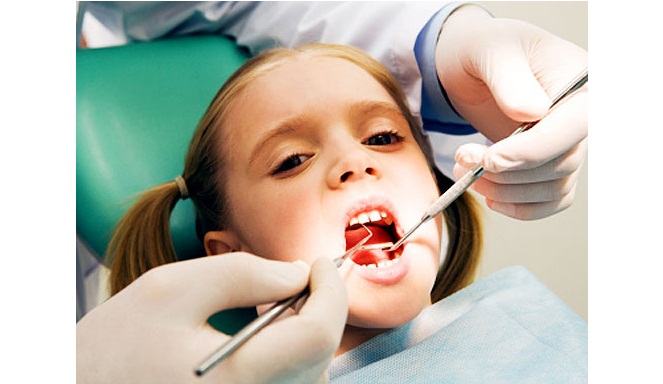Pediatric Dentistry
Pediatric Dentistry
What is Pediatric Dentistry?
Pediatric dentistry is the branch of dentistry that focuses on children from birth through adolescence. The growth and development of a child’s mouth and jaw are an important part of overall development. Pediatric dentistry focuses on promoting the development of positive oral hygiene routines at home, as well as healthy habits including diet that can help build healthy teeth and gums, while preventing decay and other dental issues.

Typical Dental Development for Children
Teething & Baby Teeth: The teething process for children can start generally anywhere from 4-10 months, but some babies are born with teeth and other babies will not get their first tooth until after they are more than a year old. This tooth eruption chart shows when you can typically expect your child’s teeth to erupt, or come through the gums. Children have a total of 20 baby teeth, and they are typically all grown in by about 33 months.
Some babies are born with some of their primary teeth already erupted, and in others, their first teeth may not come through until 12 months. We recommend that parents bring their children for their first dental visit by their first birthday, even if they only have a few teeth, or none at all. Sometimes teeth may not come in on time or at all due to certain issues in the development of the jaw, or the permanent teeth may be coming in earlier than expected. X-rays and regular monitoring can diagnose and correct most problems, and can even prevent the need for future treatment.
Parents should care for baby and toddler teeth by wiping the gums clean with a soft, wet rag or gauze, and begin brushing their baby’s teeth as soon as they appear with a soft bristled brush and water. Your dentist can review your child’s health and development with you, and recommend when to begin using toothpaste in your child’s oral hygiene routine. Typically this occurs around age 2.
Losing Baby Teeth, Growing Adult Teeth, and First Orthodontic Consultation
By age 7, many children have lost several baby teeth and have begun growing in adult teeth. The adult tooth eruption chart shows the average age children typically lose their baby teeth and grow new ones. Most of the time, baby teeth will fall out on their own, making room for adult teeth. Sometimes, however, your child’s dentist may recommend extracting a baby tooth or teeth because they may cause adult teeth to become misaligned, and may require orthodontic work to correct later on. Your child’s dentist will keep an eye on the growth and development of your child’s face and jaw, as well as the eruption of their permanent teeth and loss of baby teeth.
According to the American Association of Orthodontists, children should have their first orthodontic check-up by age 7. An orthodontic consultation can help spot any potential issues with the bite and jaw alignment, and determine if any treatment can be provided to help encourage proper alignment early on, before issues become more severe or require orthodontic treatment interventions such as braces.
Children may desire more independence when it comes to their oral hygiene routine at home. However, it is important to supervise younger children during their routine, checking to make sure their teeth are clean, and even brushing for them if needed.
Common Pediatric Dental Procedures
Regular Dental Checkups and Cleanings
Like adults, children should have regular checkup and cleaning visits every 6 months, starting at age 1. Regular visits are critical for children because they are growing and developing rapidly. Your child’s dentist will be able to monitor development, provide regular cleanings to help prevent decay and cavities, and identify issues that may require orthodontic or other intervention, which can help to avoid the need for more involved and costly treatment in the future.
Pediatric Dental Sealants
Dental sealants act as a barrier to prevent cavities. Sealants are made of a plastic material, and are usually applied to the chewing surfaces of the back teeth (premolars and molars) where decay occurs most often. Dental sealants protect these surfaces by keeping plaque and bacteria out.
Pediatric Pulpotomy (Baby Tooth Root Canal)
A pulpotomy is the surgical removal of an inflamed pulp chamber in a child’s tooth that has been compromised due to untreated cavities and decay. Bacteria must be removed from the pulp chamber inside the child’s tooth in order to prevent or alleviate an abscess or infection. A pulpotomy is commonly referred to as a “baby tooth root canal.”
Pediatric Space Maintainers
A space maintainer is a common pediatric dental treatment option. It is an appliance that is custom-made by a dentist or orthodontist in acrylic or metal material. It can be either removable or cemented in a child’s mouth. The job of a space maintainer is to keep the space between two or more baby teeth open to allow the permanent tooth to erupt and come into place.
Space maintainers are an important treatment option for children because they can help reduce or even eliminate the need for future orthodontic work such as braces later on in your child’s life.
Nitrous Oxide (Laughing Gas) and Conscious Sedation for Children
Nitrous Oxide, also known as “laughing gas,” is a safe and effective conscious sedation technique used to help both adults and children feel relaxed, relieve dental anxiety, and help make certain dental procedures easy and stress-free for patients. Nitrous oxide may also be used in combinations with other sedative agents. Nitrous oxide is perhaps the safest sedative in dentistry and is well tolerated by most patients. It has a rapid onset, is reversible, can be adjusted in various concentrations and is non-allergenic. The patient remains fully conscious and maintains all natural reflexes when breathing nitrous oxide/oxygen.
Snoring and Sleep Apnea in Children
Parents should seek the advice of a dentist if their child snores regularly or seems to have issues with breathing while sleeping. SNORING may be an indicator of a growth or development issue, and a sign of a sleeping disorder. Pediatric sleeping disorders can be a very serious condition and, if left untreated, can result in learning and cognitive delays, behavioral issues, and other problems that can last through adulthood.
Common Pediatric Dental Emergencies
No parent ever wants to see their child in pain. However, dental emergencies can sometimes occur. Some of the most common pediatric dental emergencies include:
-Toothache
-Dental Avulsion (Knocked Out Tooth)
-Dental Intrusion (tooth pushed into jaw bone)
-Tooth Displacement (luxation, Extrusion)
-Broken Tooth (crown fracture)
-Root Fracture
-Dental Concussion
It is important to note that any signs of injury to the head or neck, loss of consciousness, uncontrolled bleeding, or fever accompanied by swelling require urgent medical attention. Please bring your child to the nearest emergency center or urgent care facility for immediate attention.
First and Early Dental Visits for Young Children
Make visits to the dentist a positive and rewarding experience. The best way to make sure you and your child avoid anxieties and have a positive experience is to start visiting the dentist at 12 months of age, and to return for checkups every 6 months. This not only allows your child’s dentist to monitor growth and development and to watch for potential issues, but also allows your child to have positive and non treatment-related experiences at a dental office.
Parents can also help prepare their toddler or child for dental visits by talking, reading and learning about oral health and visiting the dentist. This way, if treatment is needed in the future, your child will already be familiar with the sights, sounds and people they will encounter during a visit to the dentist.
It is also important for parents to be mindful of their own anxiety or concerns about visiting the dentist. Children listen to what we say and often pick up on the emotions of adults, so making sure to refer to dental visits as positive experiences, and dentists, hygienists and staff as nice people who want to help keep your child healthy will go a long way towards shaping your child’s perceptions and expectations.
Cost and Insurance Coverage for Pediatric Patients
If your child has dental insurance, our insurance experts will be happy to help review the policy and coverage with you. In many cases, pediatric dental care may be covered, including orthodontic and braces treatment. If you do not have insurance coverage for your child, we will work with you to make sure your child gets the dental care he or she needs, in a way that fits your monthly budget.
How can I make a consultation or appointment for my child?
Fresh Smiles feature child-friendly doctors and staff who love working with kids and families. Contact us to book an appointment for your child, or with any questions you may have about pediatric dental care Fresh Smiles.
Frequently Asked Questions
My child has cavities, but aren’t these baby teeth just going to fall out anyway? What’s the point of treating them?
Baby teeth are very important to normal dental development in children. They help to hold space and guide adult teeth into place. Not treating dental caries in children can result in toothaches, pain, possible infection, and even medical emergencies. Teeth that are not treated will need to be extracted, resulting in premature loss.
Premature loss of baby teeth can cause adult teeth to grow in crooked and can affect your child’s ability to eat and breathe, as well their self esteem as they get older. Orthodontic treatment such as braces may be required. The best course of action is to maintain an effective oral hygiene routine at home, and to bring your child for necessary dental treatment to help them have a healthy smile for life.
When should I start flossing my child’s teeth?
We recommend flossing your child’s teeth as soon as they will tolerate (hold still for) it. The age range varies a bit, as each child is different, but usually by age 3 you can regularly floss your child’s teeth. Children love to imitate what they see, so demonstrating how brushing and flossing works and talking about how important it is to have healthy teeth can help encourage your child to want to floss.
My child’s adult teeth look darker or more yellow than the baby teeth! Why?
Baby teeth often come in lighter in color than permanent teeth, so sometimes parents may worry that the permanent teeth look more ivory or yellow COMPARED to the baby teeth. Both baby teeth and permanent teeth can be very sharp, especially at first. This is normal and helps them to erupt through the gums. This is especially true of the second set, or permanent teeth. The sharp or serrated edges on anterior (front) permanent teeth are called “mamelons.” However, discoloration of a tooth or teeth can be a sign of decay or trauma, especially if the color changes over time. It’s a good idea to bring your child in for a checkup if you are worried.
